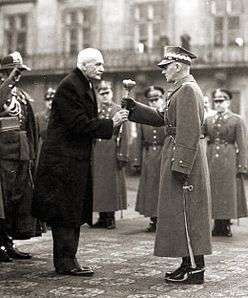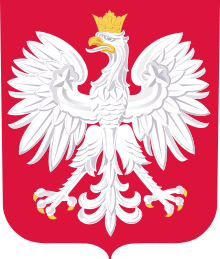Bulawa
The bulawa or bulava (Polish spelling: buława; Ukraine, булава [bula'va]) is a ceremonial mace or baton.
Poland, Grand Duchy of Lithuania, Polish-Lithuanian Commonwealth.
Historically the buława was an attribute of a Hetman, an officer of the highest military rank (after the monarch) in 15th- to 18th-century Kingdom of Poland and the Polish-Lithuanian Commonwealth.
Hetmans typically added an image of a bulawa to their coats of arms.
Today the buława appears in the rank insignia of a Marshal of Poland.
Ukraine
In Ukrainian language, булава bulava is a mace or a club, in both the military and ceremonial senses. The bulava was part of the Ukrainian Cossack Kleinody that were awarded by Hetman Bohdan Khmelnytsky to the Zaporizhian Host.[1]
Historically the bulava was an attribute of a Hetman, an officer of the highest military rank and of the Otaman of Ukraine or the military head of a Cossack state (Cossack Hetmanate).
Under the Ukrainian People's Republic, the General Staff of the Ukrainian Army was called the General Bulava.
The bulava is also an official symbol of the President of Ukraine (now), being housed in Ukraine's Vernadsky National Library.
Gallery

 Edward Rydz-Śmigły (right) receiving Marshal's buława from Polish President Ignacy Mościcki, Warsaw, 10 November 1936.
Edward Rydz-Śmigły (right) receiving Marshal's buława from Polish President Ignacy Mościcki, Warsaw, 10 November 1936.- Coat-of-arms of a Polish hetman
- Buława of Crown Field Hetman Marcin Kalinowski
 Bulawa of Ukraine's hetman Bohdan Khmelnytsky. XVII.
Bulawa of Ukraine's hetman Bohdan Khmelnytsky. XVII. Souvenir bulawas in Kiev market
Souvenir bulawas in Kiev market 17th century Russian bulat steel bulawa.
17th century Russian bulat steel bulawa.
See also
| Wikimedia Commons has media related to Bulawa. |
